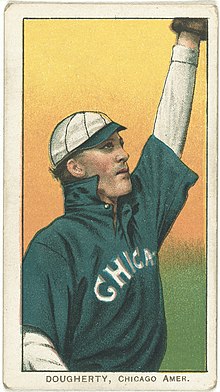| Patsy Dougherty | |
|---|---|
 | |
| Outfielder | |
| Born: October 27, 1876 Andover, New York, U.S. | |
| Died: April 30, 1940 (aged 63) Bolivar, New York, U.S. | |
Batted: Left Threw: Right | |
| MLB debut | |
| April 19, 1902, for the Boston Americans | |
| Last MLB appearance | |
| September 22, 1911, for the Chicago White Sox | |
| MLB statistics | |
| Batting average | .284 |
| Home runs | 17 |
| Run batted in | 413 |
| Teams | |
| |
| Career highlights and awards | |
| |
Patrick Henry "Patsy" Dougherty (October 27, 1876 – April 30, 1940) was an American Major League Baseball outfielder from 1902 to 1911. He played for the Boston Americans (now the Boston Red Sox), the New York Highlanders (now the New York Yankees), and the Chicago White Sox.
On July 29, 1903, Dougherty became the second Red Sox player (then known as the Americans) to hit for the cycle. [1] In Game 2 of the 1903 World Series, the first modern World Series, Dougherty became the first player to accomplish several feats; he became the first Boston player to hit a World Series home run, [2] the first player to hit two home runs in a single World Series game, and the first player to hit a leadoff inside-the-park home run in a World Series game (a feat not matched until the 2015 World Series, by Alcides Escobar of the Kansas City Royals in Game 1).
In a 10-year major league career, covering 1233 games, Dougherty compiled a .284 batting average (1294-for-4558) with 678 runs, 17 home runs, 413 RBI and 261 stolen bases. In his two postseason appearances, in the 1903 and '06 World Series, he batted .185 (10-for-54) with 2 home runs and 6 RBI.
Dougherty died in Bolivar, New York, at the age of 63 and was buried at St. Mary Catholic Cemetery in Bolivar. [3]
See also
- List of Major League Baseball players to hit for the cycle
- List of Major League Baseball career stolen bases leaders
- List of Major League Baseball annual runs scored leaders
- List of Major League Baseball annual stolen base leaders
References
- ^ Smith, Christopher (June 17, 2015). "List of the 20 Boston Red Sox players who have hit for the cycle starting with Brock Holt". masslive.com. Retrieved October 19, 2017.
- ^ Patsy Dougherty - BaseballBiography.com
- ^ Baseball-Almanac.com. Retrieved October 24, 2006.
Further reading
- Anselmo, Ray. "Patsy Dougherty". SABR. Retrieved October 19, 2017.
External links
- Career statistics and player information from Baseball Reference, or Baseball Reference (Minors), or Retrosheet
- Patsy Dougherty at Find a Grave
- American League stolen base champions
- Boston Americans players
- Chicago White Sox players
- New York Highlanders players
- Major League Baseball left fielders
- Bristol Braves players
- Canandaigua Giants players
- Olean (minor league baseball) players
- Dayton Old Soldiers players
- Los Angeles Angels (minor league) players
- Bridgeport Orators players
- Baseball players from Allegany County, New York
- 1876 births
- 1940 deaths
- Baseball left fielder stubs